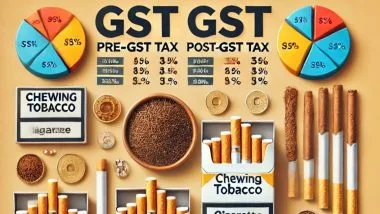GST (The Goods and Services Tax ) regime in India is poised for a significant shift as the Group of Ministers (GoM) on GST rate rationalization has recommended introducing a new 35% tax slab for demerit goods, including tobacco, cigarettes, and aerated beverages. This marks a substantial increase from the current top tax slab of 28% for such items, highlighting the government’s intent to augment revenue collection while discouraging the consumption of these “sin goods.”
The GoM, led by Bihar Deputy Chief Minister Samrat Choudhary, convened on December 2, 2024, to finalize its report on various GST rate adjustments. The recommendations aim to strike a balance between revenue enhancement and affordability for essential goods, setting the stage for potential restructuring within the GST framework.
Proposed Changes for Sin Goods
The key proposal emerging from the GoM meeting involves levying a special 35% GST rate on products such as tobacco, cigarettes, and aerated drinks. Officials argue that this move could help offset revenue losses stemming from rate reductions on essential items.
Demerit goods like tobacco and aerated beverages currently attract a 28% GST, coupled with a cess. Increasing the GST to 35% is expected to yield significant revenue while simultaneously discouraging consumption. An official source emphasized, “This special rate will help minimize revenue loss due to reductions in GST rates on other items.”
Broader Rate Rationalization for 148 Items
The GoM’s report proposes tax adjustments for 148 products, introducing nuanced slabs for different price categories, particularly in apparel. The revised structure for readymade garments includes:
- Up to ₹1,500: 5% GST
- ₹1,500 to ₹10,000: 18% GST
- Above ₹10,000: 28% GST
These changes align with the government’s broader strategy to link taxation with product pricing. High-end goods like luxury watches, expensive shoes, and cosmetics are also expected to face higher tax rates, transitioning India’s GST regime toward a consumption-based tax structure.
Impact on Essential and Common-Use Items
To make GST more equitable, the GoM has proposed rate reductions for several everyday items. Key recommendations from their previous October meeting include:
- Packaged Drinking Water (20 litres and above): Reduction from 18% to 5%.
- Bicycles costing less than ₹10,000: Reduction from 12% to 5%.
- Exercise Notebooks: Reduction from 12% to 5%.
These measures aim to reduce the tax burden on middle- and lower-income groups while promoting affordability.
Implications for High-End Goods
Luxury items like shoes priced above ₹15,000 and wristwatches costing more than ₹25,000 are expected to be shifted to the highest GST slab of 28% from the current 18%. The rationale behind this increase is to target discretionary spending while ensuring that high-income consumers contribute more to indirect tax revenues.
Existing The Goods and Services Tax Structure and Its Challenges
Under the current the Goods and Services Tax system, essential items are either exempt or taxed at lower rates, while luxury and demerit goods are taxed higher. The existing four-slab structure—5%, 12%, 18%, and 28%—has faced criticism for its complexity and revenue inefficiencies.
By introducing a special 35% slab, the government aims to simplify the tax regime while addressing revenue shortfalls. However, this shift also raises concerns about compliance and administrative challenges, particularly for industries affected by the higher tax rates.
The Path Forward: The Goods and Services Tax Council Meeting on December 21
The GoM’s recommendations will be presented to the GST Council on December 21, 2024, in Jaisalmer. Chaired by the Union Finance Minister and comprising state finance ministers, the council will have the final say on the proposed changes. Key discussions will include:
- Approval of the 35% GST rate for sin goods.
- Tax exemptions for life and health insurance premiums.
- Extension of the GoM’s mandate for periodic reviews of GST rates.
Proposals on Insurance Premiums
In a consumer-friendly move, the council is likely to exempt certain health and life insurance premiums from GST. Key considerations include:
- Senior Citizens’ Health Insurance: Full exemption on premiums.
- Health Insurance for Coverage up to ₹5 Lakh: Exempted for all.
- Coverage above ₹5 Lakh: Taxed at the current rate of 18%.
These adjustments aim to reduce the financial burden on policyholders, especially senior citizens, while maintaining revenue neutrality.
Challenges and Opportunities Ahead
The GoM’s proposals represent the first major overhaul of GST rates in seven years, signaling a shift toward a more dynamic and responsive taxation system. By targeting demerit goods with higher rates, the government hopes to discourage harmful consumption patterns while boosting revenue.
However, this move also poses challenges. Higher taxes on sin goods may lead to an increase in illicit trade and tax evasion, as seen in the tobacco industry. Moreover, businesses affected by rate hikes may face operational and compliance hurdles, particularly small and medium enterprises (SMEs).
Conclusion: Balancing Revenue and Equity
The proposed The Goods and Services Tax adjustments reflect the government’s attempt to balance revenue generation with social and economic equity. By taxing luxury and sin goods at higher rates, the system ensures that wealthier consumers contribute more. Simultaneously, rate cuts for essential and common-use items aim to make GST more inclusive for the masses.
As the The Goods and Services Tax Council deliberates on these proposals, its decisions will shape the trajectory of India’s indirect tax regime. Stakeholders across industries and consumer groups eagerly await the outcomes, which promise to have far-reaching implications for the economy and society at large.

